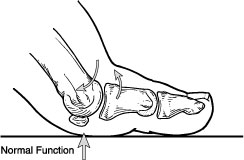Boomers Not Backing Down from Foot and Ankle Arthritis
Surgical advances keeping them active, pain-free.
They danced to the Beatles, the Rolling Stones and disco. They worked out with Jane Fonda and made jogging their national pastime.
Now approaching retirement, many members of the "Me Generation" aren't ready to slow down, even if their bodies are. Foot and ankle surgeons say Baby Boomers are more likely than previous generations to seek care when arthritis develops in their toes, feet and ankles.
"Unlike their parents, Baby Boomers do not accept foot pain as a natural part of aging," says John Giurini, DPM, a Boston foot and ankle surgeon and a past president of the American College of Foot and Ankle Surgeons. "When conservative treatments fail, they want to know what other options exist."
There are more than 100 different types of arthritis, including gout and rheumatoid arthritis. The most common forms to affect the feet are posttraumatic and osteoarthritis, especially in the big toe, ankle and midfoot joints.
"This generation has witnessed an explosion of new medical technology during its lifetime," says Stephen Frania, DPM, a Cleveland foot and ankle surgeon. "They have high expectations, sometimes too high."
Surgeons say many Boomers who seek treatment for arthritis assume they'll be able to resume activities, such as running or playing sports. Seeking treatment early can improve the odds of preventing irreversible joint damage. For many patients with early-stage foot or ankle arthritis, changes in shoes or advanced custom orthotics can make a huge difference. While there is no fountain of youth for arthritis, surgeons say there are more medical options available to Baby Boomers than ever before.
Big Toes
 Baby Boomers are most likely to develop osteoarthritis in their big toe joint. During walking, the big toe absorbs forces equal to nearly twice a person's body weight. It plays an important role in stooping and standing. Some boomers start to develop big toe stiffness, a condition called hallux limitus, in their forties.
Baby Boomers are most likely to develop osteoarthritis in their big toe joint. During walking, the big toe absorbs forces equal to nearly twice a person's body weight. It plays an important role in stooping and standing. Some boomers start to develop big toe stiffness, a condition called hallux limitus, in their forties.
Better surgical procedures now offer improved pain relief and better joint movement to Boomers with early-stage arthritis at the big toe. Patients with advanced and severe arthritis may need to have the joint fused or replaced. But stronger screws and hardware are helping fusions last longer while slashing recovery times. A new generation of big toe joint replacements shows promise.
Ankles
 Ankles are another prime spot for arthritis. Ankles are more likely to develop posttraumatic arthritis than osteoarthritis. For many Baby Boomers, the trauma was an ankle fracture or a bad sprain that may have happened in their teens or twenties. Innovative new surgical techniques allow foot and ankle surgeons to transplant small plugs of cartilage from one part of the ankle to another in some patients, slowing joint deterioration.
Ankles are another prime spot for arthritis. Ankles are more likely to develop posttraumatic arthritis than osteoarthritis. For many Baby Boomers, the trauma was an ankle fracture or a bad sprain that may have happened in their teens or twenties. Innovative new surgical techniques allow foot and ankle surgeons to transplant small plugs of cartilage from one part of the ankle to another in some patients, slowing joint deterioration.
Ankle replacements, however, are not as durable as hip and knee replacements. The ankle is a more challenging joint to replace. It's smaller and moves in multiple directions. But better and more promising ankle implants are hitting the market.
"Surgery to repair arthritic feet and ankles won't make you 16 years old again," says Brad Wenstrup, DPM, a Cincinnati foot and ankle surgeon. "But Boomers can look forward to more options than ever to relieve pain and restore motion."